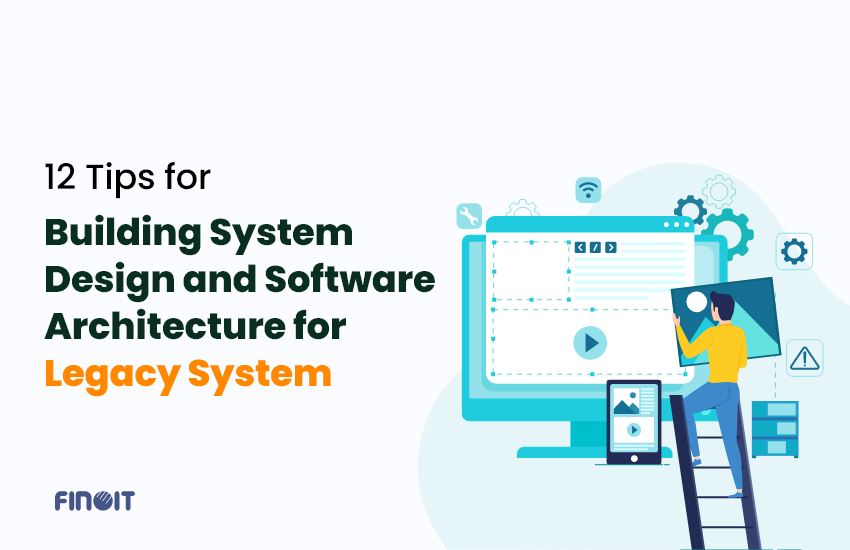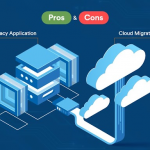12 Tips for Building System Design and Software Architecture for Legacy System

At a time when the term “legacy system” might trigger an imagination of outdated, cumbersome infrastructures struggling to keep up with modern demands, and most are considering legacy application migration to cloud, the reality is far from this stereotype. Enterprises still rely on robust legacy systems, recognizing their stability, reliability, and extensive knowledge base.
Yet, designing the architecture for a legacy system is a journey fraught with complexities. Building a scalable legacy system thus requires a nuanced approach, where the insights of seasoned legacy system development experts become invaluable. They offer time-tested tips that stand as best practices in building software architecture for legacy systems.
Having said that, the 12 tips discussed below will serve as a roadmap for navigating the intricacies of building a high-performance legacy system.
Tips to build system design and software architecture for a solid legacy system
Building a robust software architecture for a legacy system is crucial for long-term viability. Follow these practical tips to build an adaptable architecture and preserve functionality and future-proof your legacy system.
1. Adopt Long-Term Compatible Technologies
When designing a legacy software system, it is important to choose technologies with a proven track record of adaptability. When building such a system, it’s critical to select tools, software development languages, and frameworks that are unlikely to become obsolete or unsupported in the foreseeable future.
You can select widely adopted programming languages like Java, Python, or JavaScript, which have been in use for years and continue to evolve with strong community support. Furthermore, it’s advisable to choose stable and well-established frameworks and libraries. For instance, if you’re developing a web application, frameworks like Django (for Python) or Spring (for Java) have a long history of reliability and are continually updated to meet modern requirements.
Additionally, consider the compatibility of the chosen technologies with emerging paradigms. For instance, technologies that support microservices architecture or containerization (e.g., Docker) ensure adaptability to evolving trends in software development.
By prioritizing long-term compatibility, you mitigate the risk of the technology stack becoming outdated or unsupported, which helps ensure the legacy system remains viable, secure, and maintainable for years to come.
2. Prioritize Comprehensive Documentation and Maintain Clean Code
Well-organized documentation is more than essential in building a solid legacy system that encompasses a wide range of information crucial for understanding, maintaining, and extending the system over time.
Technical documentation should include architecture diagrams that illustrate the system’s high-level structure, outlining components, modules, and their interactions. The visual representation aids developers in grasping the system’s design at a glance.
Code-level documentation is equally vital and it entails well-commented source code, providing detailed explanations of algorithms, functions, classes, and complex logic. Clear and concise comments enable developers to quickly comprehend the purpose and functionality of different parts of the codebase.
API documentation should be comprehensive, detailing the endpoints, input parameters, expected outputs, and any authentication requirements. This type of documentation facilitates smooth integration with external systems and allows for effective collaboration between development teams.
Finally, user manuals and guides are essential for non-technical stakeholders and end-users. They should offer step-by-step instructions for system installation, configuration, and usage, ensuring a seamless experience for those interacting with the legacy system.
3. Embrace Modular Design
Design patterns play a crucial role in implementing modular design, as these are established solutions to common design problems, offering proven approaches for structuring code. For instance, the “Module Pattern” in JavaScript encapsulates functionality within a single object, promoting clean, organized code.
As a result, you should break down a system into independent, interchangeable modules, where each module addresses a specific functionality, allowing for easier development, maintenance, and scalability.
Architects use modular design to create a system where changes to one module do not necessitate alterations in other parts. For promoting code reusability and reducing the risk of unintended consequences when making updates, this step is essential. Modular design also contributes to collaborative development, which means different teams can work on separate modules concurrently, reducing development time and minimizing conflicts. Incorporating Design Thinking in Software Development further enhances this approach by focusing on user-centered design and iterative problem-solving, aligning the development process with user needs and expectations.
Next, deploying a system with a modular architecture provides benefits in terms of scalability. You can add or replace modules with minimal impact on the overall system, allowing for efficient adaptation to changing requirements.
4. Avoid Over-Engineering
Over-engineering often involves implementing solutions that exceed the requirements or introducing unnecessary features, leading to bloated code, increase in development time, and potential difficulties in maintenance.
You need to be cautious of not running into overdoing the engineering act which can lead to unnecessary complexity or sophistication. Developers must strike a balance between adhering to best practices and optimizing for the specific needs of the project.
Following best practices is important, but it’s equally crucial to avoid overcomplicating simple tasks. For example, using a simple loop to iterate through a small dataset is more efficient than implementing a complex parallel processing mechanism.
Additionally, optimizing code should be based on actual performance bottlenecks rather than premature optimization. Developers should focus on critical areas that significantly impact the system’s performance and user experience.
When you end up overdoing things, it leads to a steeper learning curve for developers, making it harder for new team members to understand and contribute to the codebase.
Also Read: how to reduce software development costs
5. Adhere to Industry Standards
Industry standards encompass various aspects of software development, such as coding conventions, data exchange formats, communication protocols, and security practices. By adhering to these standards, developers can create systems that are more maintainable, secure, and compatible with other software components.
One example of industry standards is the use of widely accepted design patterns like Model-View-Controller (MVC) in web development. It is an architectural pattern that helps organize code, separating concerns and making it easier for developers to collaborate on projects. Development teams must make use of such standards to streamline legacy system building.
Adhering to industry standards also promotes interoperability. Systems built following established protocols can easily integrate with other software components, reducing compatibility issues and enhancing the system’s overall functionality.
And what about adhering to security standards for securing protection against vulnerabilities and cyber threats? Following standard practices like secure coding, encryption, and access controls helps safeguard sensitive data and prevent unauthorized access.
6. Design for Flexibility
Flexible design emphasizes building systems capable of adapting to changing requirements or environments without requiring extensive re-engineering. You build components and interfaces in a way that allows for easy modification or extension.
One key aspect of designing for flexibility is the use of interfaces that define contracts which specify how different parts of a system should interact. By programming to interfaces rather than concrete implementations, developers can easily swap out components or extend functionality without affecting the rest of the system. For example, in Java, interfaces provide a blueprint for classes, allowing for polymorphism and easy substitution of implementations.
Additionally, employing design patterns like the Strategy Pattern or Dependency Injection assists in realizing flexibility in the system. These patterns allow for interchangeable algorithms or components, enabling the system to adapt to different use cases or requirements without major code modifications.
Decoupling is another crucial technique in achieving flexibility, involving minimization of dependencies between different modules or components. Changes in one part of the system have minimal impact on other parts, which enhances flexibility.
7. Beware of Vendor Lock-In
Excessive reliance on a particular vendor’s proprietary technologies, tools, or solutions, can lead to reduced system flexibility, increased costs, and complications during system migration or updates.
From a technical standpoint, vendor lock-in can manifest in several ways. Firstly, it may involve the use of specialized communication protocols or application programming interfaces (APIs) unique to the vendor. However, this can create a challenge in integrating the system with other platforms or transitioning to alternative solutions.
Additionally, if the system relies on custom extensions or plugins provided exclusively by the vendor, compatibility issues may arise when attempting to migrate or adopt a different vendor’s platform. Another technical aspect is that of data storage formats; if the system employs a proprietary data format, extracting and transferring data to an alternative system or platform can turn out to be a formidable task.
Furthermore, a dependency on vendor-specific tools for development, deployment, or maintenance processes can contribute to lock-in. Transitioning away from these tools may entail substantial effort and reconfiguration, which underscores the importance of adopting open standards and technologies.
The above step will ensure that the system’s dependencies are well-documented, and explore alternatives to proprietary solutions. The measure will mitigate the risks associated with vendor lock-in and promote a more adaptable and sustainable legacy system architecture.
8. Implement Version Control and Source Code Management
At its core, version control provides a structured approach to handling codebase modifications, and it allows multiple developers to work concurrently without interfering with each other’s progress.
Version control systems like Git, SVN, or Mercurial steer the practice of version control. These systems maintain a repository of the codebase, recording every change made by developers along with comments explaining the alterations. Developers can create branches, essentially separate lines of development, to work on specific features or bug fixes independently. Through merging, these branches can be integrated back into the main codebase, so that changes are systematically tracked and integrated in an organized manner.
Source code management, a subset of version control, encompasses processes for organizing, storing, and retrieving code. It is important to manage source code, as it involves practices such as naming conventions, directory structures, and documentation standards.
Last but not least, you must drive version control to manage rollbacks, which will aid you in debugging and troubleshooting. Additionally, version control systems integrate with continuous integration and continuous deployment (CI/CD) pipelines, automating the process of testing and deploying code changes.
9. Prioritize Security Measures
Firstly, regular security audits and vulnerability assessments should be conducted to identify potential weaknesses in the system. Access controls and authentication mechanisms are fundamental technical measures in this process. You should start by setting up roles and permissions, so that users and processes only have access to the resources they absolutely need. Multi-factor authentication, strong password policies, and secure login mechanisms are some basic but essential steps to further fortify the system.
Protecting sensitive data both in transit and at rest is ever critical for which leverage algorithms that convert data into a format that is unreadable without the appropriate decryption key. And then comes regular patch management, which helps ensure that the system’s software and dependencies are up-to-date and helps protect against known vulnerabilities that could be exploited by attackers.
In the event of a security incident, security logs are invaluable for forensic analysis and understanding the nature of the breach. The last step is to educate the development and operations teams about security best practices and conduct regular security training sessions. You must strive to create a culture of security awareness and ensure that all team members understand their role in maintaining a secure system.
10. Establish Error Handling and Logging
Consider all relevant techniques and code structures and put them all in place to gracefully manage exceptions, faults, or errors that may occur during the execution of the system. Some steps include using try-catch blocks in languages like Java or employing exception handling in languages like Python.
Implement error tracking tools such as Sentry or Rollbar to fetch real-time notifications and detailed error reports when exceptions occur. These tools assist development teams in quickly responding to and resolving issues.
In terms of logging, use libraries or frameworks to capture important details, such as timestamps, error codes, stack traces, and contextual information. Keep track of logging levels (e.g., debug, info, warning, error, etc.) to dive into different levels of granularity in recording events, which aids in diagnosing issues.
Centralized log management systems, such as ELK Stack (Elasticsearch, Logstash, and Kibana) or Splunk, aggregate and analyze logs from various components of the system and can prove helpful in resolving intricate error-handling tasks.
11. Design for Scalability and Performance
To build a scalable legacy system you need a scalable architecture which leads you to employing scalable architectural patterns, such as microservices or serverless computing, as components must be independently scalable based on demand. Assistance from a legacy application modernization company can greatly help in this direction.
Achieving scalability revolves around filtering out appropriate database technologies and implementing effective indexing and partitioning strategies to optimize data retrieval and storage. Utilizing caching mechanisms and distributed databases can further enhance performance by reducing the load on the primary database.
Efficient resource management is equally crucial, as it includes optimizing algorithms and data structures to ensure that operations are executed with minimal computational overhead. Implement asynchronous programming and parallel processing to improve system responsiveness and throughput.
Then there are scores of incoming requests across multiple servers that may prevent a single component from becoming a bottleneck. So, start implementing auto-scaling policies to allow the system to dynamically allocate resources in response to fluctuating demand.
12. Implement a Thorough Testing Strategy
Testing should start with unit testing where you test individual units or components of the system in isolation to verify that they function as intended. Go for automated unit tests for catching regressions and validating the behavior of code during development and maintenance.
Next comes integration testing with which you can verify the interactions between different components of the system. Techniques like mocking and stubbing may be employed to isolate specific components for testing. Implement Continuous integration (CI) pipelines to automate the process of running tests whenever code changes are made, providing rapid feedback to the development team.
For identifying and addressing unintended side effects or issues introduced by code modifications use automated regression tests. You will validate that existing functionalities remain intact after new code is integrated into the system.
Performance testing involves evaluating the system’s responsiveness, scalability, and stability under various levels of load and stress. You must implement load-testing tools to simulate real-world usage scenarios to assess how the proposed legacy system performs under different conditions.
For the security dimension, security testing, including techniques like penetration testing and code scanning, aims to identify vulnerabilities and weaknesses in the system that could be exploited by attackers. Then, user acceptance testing (UAT) involves engaging end-users to validate that the system meets their requirements and expectations.
Use the tips to best architect your legacy system
Each tip discussed here is equally important in building a robust and adaptable system. However, their effective implementation calls for a deft touch and profound expertise. This is a nuanced process, one that necessitates the guidance of seasoned professionals like those from Finoit.
Engaging a proficient legacy system designing company is not just a choice, but a strategic imperative. Their knowledge and hands-on proficiency can take your legacy system development in the right direction. To discuss queries around your legacy system development project and for assistance, connect with our experts or write to us at info@finoit.com.


